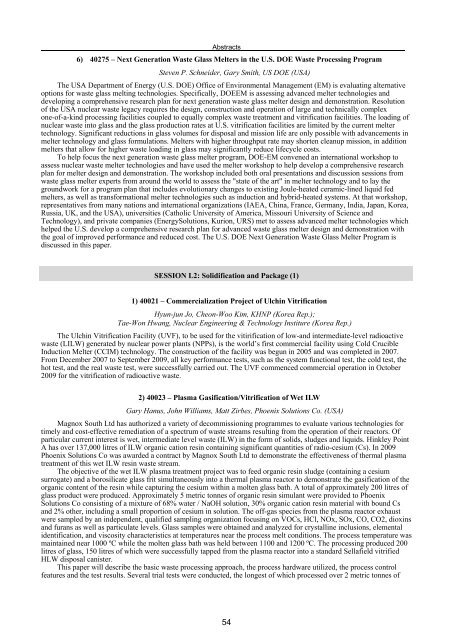The 13th International Conference on Environmental ... - Events
The 13th International Conference on Environmental ... - Events
The 13th International Conference on Environmental ... - Events
You also want an ePaper? Increase the reach of your titles
YUMPU automatically turns print PDFs into web optimized ePapers that Google loves.
Abstracts<br />
6) 40275 – Next Generati<strong>on</strong> Waste Glass Melters in the U.S. DOE Waste Processing Program<br />
Steven P. Schneider, Gary Smith, US DOE (USA)<br />
<str<strong>on</strong>g>The</str<strong>on</strong>g> USA Department of Energy (U.S. DOE) Office of Envir<strong>on</strong>mental Management (EM) is evaluating alternative<br />
opti<strong>on</strong>s for waste glass melting technologies. Specifically, DOEEM is assessing advanced melter technologies and<br />
developing a comprehensive research plan for next generati<strong>on</strong> waste glass melter design and dem<strong>on</strong>strati<strong>on</strong>. Resoluti<strong>on</strong><br />
of the USA nuclear waste legacy requires the design, c<strong>on</strong>structi<strong>on</strong> and operati<strong>on</strong> of large and technically complex<br />
<strong>on</strong>e-of-a-kind processing facilities coupled to equally complex waste treatment and vitrificati<strong>on</strong> facilities. <str<strong>on</strong>g>The</str<strong>on</strong>g> loading of<br />
nuclear waste into glass and the glass producti<strong>on</strong> rates at U.S. vitrificati<strong>on</strong> facilities are limited by the current melter<br />
technology. Significant reducti<strong>on</strong>s in glass volumes for disposal and missi<strong>on</strong> life are <strong>on</strong>ly possible with advancements in<br />
melter technology and glass formulati<strong>on</strong>s. Melters with higher throughput rate may shorten cleanup missi<strong>on</strong>, in additi<strong>on</strong><br />
melters that allow for higher waste loading in glass may significantly reduce lifecycle costs.<br />
To help focus the next generati<strong>on</strong> waste glass melter program, DOE-EM c<strong>on</strong>vened an internati<strong>on</strong>al workshop to<br />
assess nuclear waste melter technologies and have used the melter workshop to help develop a comprehensive research<br />
plan for melter design and dem<strong>on</strong>strati<strong>on</strong>. <str<strong>on</strong>g>The</str<strong>on</strong>g> workshop included both oral presentati<strong>on</strong>s and discussi<strong>on</strong> sessi<strong>on</strong>s from<br />
waste glass melter experts from around the world to assess the "state of the art" in melter technology and to lay the<br />
groundwork for a program plan that includes evoluti<strong>on</strong>ary changes to existing Joule-heated ceramic-lined liquid fed<br />
melters, as well as transformati<strong>on</strong>al melter technologies such as inducti<strong>on</strong> and hybrid-heated systems. At that workshop,<br />
representatives from many nati<strong>on</strong>s and internati<strong>on</strong>al organizati<strong>on</strong>s (IAEA, China, France, Germany, India, Japan, Korea,<br />
Russia, UK, and the USA), universities (Catholic University of America, Missouri University of Science and<br />
Technology), and private companies (EnergySoluti<strong>on</strong>s, Kuri<strong>on</strong>, URS) met to assess advanced melter technologies which<br />
helped the U.S. develop a comprehensive research plan for advanced waste glass melter design and dem<strong>on</strong>strati<strong>on</strong> with<br />
the goal of improved performance and reduced cost. <str<strong>on</strong>g>The</str<strong>on</strong>g> U.S. DOE Next Generati<strong>on</strong> Waste Glass Melter Program is<br />
discussed in this paper.<br />
SESSION L2: Solidificati<strong>on</strong> and Package (1)<br />
1) 40021 – Commercializati<strong>on</strong> Project of Ulchin Vitrificati<strong>on</strong>�<br />
Hyun-jun Jo, Che<strong>on</strong>-Woo Kim, KHNP (Korea Rep.);<br />
Tae-W<strong>on</strong> Hwang, Nuclear Engineering & Technology Institure (Korea Rep.)<br />
<str<strong>on</strong>g>The</str<strong>on</strong>g> Ulchin Vitrificati<strong>on</strong> Facility (UVF), to be used for the vitirificati<strong>on</strong> of low-and intermediate-level radioactive<br />
waste (LILW) generated by nuclear power plants (NPPs), is the world’s first commercial facility using Cold Crucible<br />
Inducti<strong>on</strong> Melter (CCIM) technology. <str<strong>on</strong>g>The</str<strong>on</strong>g> c<strong>on</strong>structi<strong>on</strong> of the facility was begun in 2005 and was completed in 2007.<br />
From December 2007 to September 2009, all key performance tests, such as the system functi<strong>on</strong>al test, the cold test, the<br />
hot test, and the real waste test, were successfully carried out. <str<strong>on</strong>g>The</str<strong>on</strong>g> UVF commenced commercial operati<strong>on</strong> in October<br />
2009 for the vitrificati<strong>on</strong> of radioactive waste.<br />
2) 40023 – Plasma Gasificati<strong>on</strong>/Vitrificati<strong>on</strong> of Wet ILW<br />
Gary Hanus, John Williams, Matt Zirbes, Phoenix Soluti<strong>on</strong>s Co. (USA)<br />
Magnox South Ltd has authorized a variety of decommissi<strong>on</strong>ing programmes to evaluate various technologies for<br />
timely and cost-effective remediati<strong>on</strong> of a spectrum of waste streams resulting from the operati<strong>on</strong> of their reactors. Of<br />
particular current interest is wet, intermediate level waste (ILW) in the form of solids, sludges and liquids. Hinkley Point<br />
A has over 137,000 litres of ILW organic cati<strong>on</strong> resin c<strong>on</strong>taining significant quantities of radio-cesium (Cs). In 2009<br />
Phoenix Soluti<strong>on</strong>s Co was awarded a c<strong>on</strong>tract by Magnox South Ltd to dem<strong>on</strong>strate the effectiveness of thermal plasma<br />
treatment of this wet ILW resin waste stream.<br />
<str<strong>on</strong>g>The</str<strong>on</strong>g> objective of the wet ILW plasma treatment project was to feed organic resin sludge (c<strong>on</strong>taining a cesium<br />
surrogate) and a borosilicate glass frit simultaneously into a thermal plasma reactor to dem<strong>on</strong>strate the gasificati<strong>on</strong> of the<br />
organic c<strong>on</strong>tent of the resin while capturing the cesium within a molten glass bath. A total of approximately 200 litres of<br />
glass product were produced. Approximately 5 metric t<strong>on</strong>nes of organic resin simulant were provided to Phoenix<br />
Soluti<strong>on</strong>s Co c<strong>on</strong>sisting of a mixture of 68% water / NaOH soluti<strong>on</strong>, 30% organic cati<strong>on</strong> resin material with bound Cs<br />
and 2% other, including a small proporti<strong>on</strong> of cesium in soluti<strong>on</strong>. <str<strong>on</strong>g>The</str<strong>on</strong>g> off-gas species from the plasma reactor exhaust<br />
were sampled by an independent, qualified sampling organizati<strong>on</strong> focusing <strong>on</strong> VOCs, HCl, NOx, SOx, CO, CO2, dioxins<br />
and furans as well as particulate levels. Glass samples were obtained and analyzed for crystalline inclusi<strong>on</strong>s, elemental<br />
identificati<strong>on</strong>, and viscosity characteristics at temperatures near the process melt c<strong>on</strong>diti<strong>on</strong>s. <str<strong>on</strong>g>The</str<strong>on</strong>g> process temperature was<br />
maintained near 1000 ºC while the molten glass bath was held between 1100 and 1200 ºC. <str<strong>on</strong>g>The</str<strong>on</strong>g> processing produced 200<br />
litres of glass, 150 litres of which were successfully tapped from the plasma reactor into a standard Sellafield vitrified<br />
HLW disposal canister.<br />
This paper will describe the basic waste processing approach, the process hardware utilized, the process c<strong>on</strong>trol<br />
features and the test results. Several trial tests were c<strong>on</strong>ducted, the l<strong>on</strong>gest of which processed over 2 metric t<strong>on</strong>nes of<br />
54
















